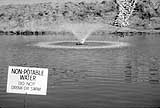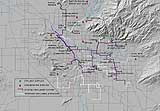
| ch. 5, pp. 46 - 48 |
Central Arizona Project CAP is potentially our largest renewable water source, although the only current direct use of CAP water in the municipal sector occurs for treatment plant maintenance — about 200 acre-feet in 1997. CAP’s potential as a water source obviously is not fully realized. Effluent Effluent use currently meets about five percent of municipal water demand. Of the 69,400 acre-feet of effluent produced at the Ina Road and Roger Road wastewater treatment plants in 1998, about 13,000 acre-feet was reused, with the rest discharged to the Santa Cruz River channel, where some 96 percent eventually recharges the aquifer within TAMA. Of the amount reused, approximately 1,200 acre-feet was delivered directly to turf facilities and some 3,000 acre-feet was delivered to the Cortaro Marana Irrigation District. This effluent only has secondary treatment and is mostly delivered downstream via gravity. The City of Tucson processed approximately 8,700 acre-feet of secondary treated effluent at its reclaimed water facilities located next to the Roger Road Wastewater Treatment Facility. This effluent receives further treatment (tertiary treatment) by filtration through sand filters or soil and additional disinfection. The reclaimed water then is delivered for use or is stored at the Sweetwater Underground Storage and Recovery Facility (recharge facility) to meet peak demands in the summer, primarily to irrigate golf courses.
Reclaimed water flows through a different set of pipes, separate from the potable water system. So far, $66 million has been spent building the system, including the reclamation facilities, the recharge facility and the distribution system. Tucson charges $475 per acre-foot for reclaimed water. Full cost for production and distribution of reclaimed water is about $558 per-acre foot, with $323 covering debt service and capital costs and $235 covering operation, maintenance and overhead costs. The price charged for reclaimed water is substantially lower than the wholesale price Tucson Water charges for potable water. This is done to further encourage the use of effluent.
Figure 5-5 shows Tucson’s 85-mile reclaimed water system, which has about 200 users. New users pay the cost of connecting to the system. This cost can be quite high, due to the expense of extending pipe to carry the effluent to the new user and modifying the user’s delivery system to handle effluent. A City of Tucson ordinance requires the use of effluent on new golf courses where possible. Since 1983, all new golf courses served by Tucson Water have been connected to the reclaimed water system. Currently, 12 of 16 courses in the Tucson Water service area are using reclaimed water, and one is using groundwater until effluent can be delivered. The three other courses use water from their own private wells. There is no current authority to prohibit their use of groundwater. Pima County’s 1995 zoning code amendments require that all new golf courses use effluent or CAP water for turf-related watering where available. The expense of constructing pipelines usually is the limiting factor. A new ordinance passed in March 1999 requires the use of CAP or effluent at all new golf courses within three miles of a treatment plant or CAP water line. Owners of golf courses outside those areas now have to find a way to recharge CAP water to replace the groundwater they use on golf courses . Attorneys are looking at whether this ordinance also applies to 13 existing golf courses in the county. ADWR incentives encourage the use of effluent. The most important incentive allows municipal providers to exclude effluent used on golf courses from their gpcd calculations (although the same total amount of water is actually used) which means conservation goals for individual customers can be higher. Graywater Reuse Graywater is water recovered after various indoor household uses, excluding toilet use. Graywater includes water from clothes washers, bathroom sinks, showers, baths, dishwashers and sometimes the rinse side of the kitchen sink. A graywater reuse system can be set up to capture and recycle such water for uses not requiring drinking water quality water; e.g., landscape irrigation. Approximately 60 to 65 percent of the wastewater generated from residential indoor use is graywater. The average resident generates an estimated 30 gallons of graywater per day. This is a significant source of water available to meet peak outdoor irrigation demands in the summer. Although graywater use is common in rural areas and has been practiced by many people in urban areas for years, graywater reuse is technically illegal in many places in the United States. Plumbing codes generally require water coming from the drain to be discharged to the sewage system or a septic tank. In Arizona, a permit must be obtained from the Arizona Department of Environmental Quality (ADEQ) or the Pima County Department of Environmental Quality to operate a graywater reuse system. To issue a permit, ADEQ must approve the design and construction of the system. The system must include a settling tank to settle out grit in the water and also must have a filtration device. Water to be applied to the surface of the ground (defined as within two feet of the earth’s surface) must be disinfected, meet water quality standards and be monitored. Daily testing of the samples may be required and can be expensive. Such hurdles to legal use of graywater cause many residents to forego graywater reuse, while others become “wildcat” graywater users, applying it without official approval. A survey of Tucson Water customers in the early 1990s revealed six percent of customers had graywater reuse systems. A more recent survey of Metro Water customers showed that nine percent of households use graywater. Since graywater use is illegal, respondents may be reluctant to admit to its use, and the actual percentage of those reusing graywater may be higher than surveys show.
|


